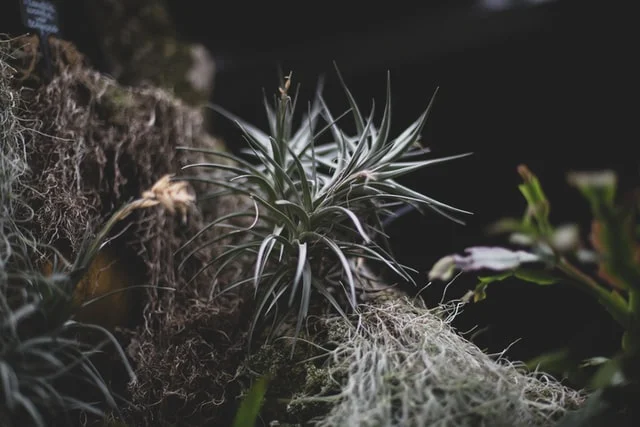Table of Contents
How to care for Tillandsia Stricta
Tillandsia Stricta plant is an evergreen species that is native to South America. In its natural environment, this plant can be found growing both on sand dunes and in trees at the bottom of the Atlantic mountain range.
These are a medium sized plants, which grow to a height of between six and twelve inches. These plants produce blue, pink, red and purple flowers.
This is a plant that has a low requirement in terms of care as it is a hardy plant that is very adaptable, therefore this plant can withstand a certain period of neglect.
What Does Tillandsia Stricta Require?
Light Requirements
Tillandsia plants tend to thrive in bright but indirect sunlight. These plants will do well when placed near a window sill, however, avoid putting them directly in sunlight.
Avoid direct sunlight as this can cause the foliage to burn.
Temperature Requirements
As with most air plants, Tillandsia Stricta tends to do well in hot climate, but it will be able to handle temperatures of between ten and thirty-two degrees centigrade.
Although Tillandsia Stricta is a hardy species of plant, it is a good idea to keep them away from air conditioning or heating units.
Intense cold or hot temperatures can be damaging for these plants, and can kill the plant. These plants will not do well in night time temperatures below four degrees centigrade especially when they are wet.
When the plants are dry, they can withstand colder temperatures for a couple of hours. These plants will not be able to tolerate frost.
Soil Requirements
Tillandsia Stricta are a species of air plants, therefore they require air and not soil. Avoid the temptation to put this plant into soil or moss as this can cause problems for the plant such as root rot, which can kill the plant.
Place this plant in a location where it can get a good circulation of air. If the plant is in a location where it needs a little more support, try using wire or fishing line but avoid using superglue or copper, as these will cause damage to the plant.
Humidity Requirements
Tillandsia Stricta plants will benefit from a regular misting, as this will give the plant moisture and humidity without overwhelming it. In climates that are hotter and drier it is a good idea to mist the plant every day, whereas in humid climate the plant would only need to be misted about every three days.
How to Water Tillandsia Stricta
The Tillandsia Stricta plant is an air plant that doesn’t require soil, therefore there is no watering requirements. These plants will need to be allowed to have a swim in water, submerge the plant in water and allow it to soak for between ten and thirty minutes.
Avoid putting the flowers of these plants into the water as this will damage it. After the plant has been submerged, remove the plant from the water and allow any excess water to drain off.
Check the plant after a couple of hours to ensure that it has dried, because if there is water trapped and left to sit for too long, it will damage the core and leaves of the plant. It is best to submerge the plant in filtered water, rain water or spring water.
Avoid using tap water on this plant as the chlorine can damage the plant.
How to Fertilise Tillandsia Stricta
Adding fertiliser can be a useful way to create a happy and healthy air plant. Fertiliser can help to encourage these plants to grow, bloom and produce pups. Although fertiliser can be helpful for these plants, it is not a necessity and the plant will grow fine without it.
Avoid giving the plant too much fertiliser as this can burn the plant and can even kill the plant. Adding fertiliser once a month will be enough for this plant and its best to use a Tillandsia or Bromeliad fertiliser.
Extra Tips for Tillandsia Stricta
Pests and Diseases
Tillandsia Stricta plants are more likely to be susceptible to pests and diseases if they are kept in dark areas or if they are continually damp.
These plants need to have light and fresh air. Mealybugs are one pest that tend to attack air plants and they will feed off the juice of the plant, which will eventually kill the plant.
If an infestation of mealybugs continues, then use an insecticidal soap that is chemical free and either spray it onto the plant or add it is the water when bathing the plant.
Pruning
There is no need to prune the Tillandsia Stricta as it will flower when mature and set seed before dying. Once the adult plant has died completely it can be pruned away whilst leaving the offsets to grow in the area where it are.
Other than pruning off the dead plant there is no pruning that is required.
Propagation
Tillandsia Stricta plants can be grown from offsets. After blooming a mature plant will produce pups at the base of the plant. If offsets are left alone then they will develop into adult plants. Separating the offset from the adult plant will create a new plant.
1. Once the plant has bloomed, it will produce pups or offsets at the base of the plant.
2. The pups can be separated from the adult plant and used to create a new plant.
3. The pup should be allowed to grow to between one third and half the size of an adult plant before it is removed.
4. It is best to do the separation in the morning. Remove the adult plant from the container.
5. Place the pup in a pot of water for a couple of hours.
6. Then remove and place it on a clean dry surface. Gently separate the leaves until the pup is exposed at the base of the adult plant.
7. Use your fingers to pull the pup away from the adult plant. Use a gentle twisting action if required.
8. As each of the pups is separated place the them into a bowl of water, as this will hydrate them.
9. Remount the main plant. Mount the pups into the new containers
10. For the initial couple of weeks give the plants a light misting and this is best done in the morning. Avoid spraying the plants at night as they breathe at night and any water on the leaves would prevent them from absorbing air.
Potting
Potting an air plant is not like potting other species of plants, as there is no need for a pot or any soil. These plants can grow on almost anything that will support the plant.
Tillandsia Stricta plants can be grown in lovely glass globes, a piece of driftwood or even in a seashell. A common way to keep these plants is in a classic terrarium, however these plants can be grown between small rocks in a garden or in twisted metal shapes.
Ensure that the plants are secure in the display that they are placed in. When kept in a metal structure, avoid letting the metal become wet, as this will cause damage to the plant.
FAQ
How Do You Take Care of Stricta Tillandsia?
Stricta Tillandsia likes to be in areas that have a good circulation of air, therefore it is best kept in areas that are well ventilated.
These plants should be watered once or twice a week based on the environment where they live. These plants are watered by submerging them in water for about thirty minutes.
How Do You Keep Air Plants Alive?
There are a few tips that can be used when dealing with air plants.
1. It is best to dunk these plants into water as a way of watering them.
2. After soaking these plants allow them to air dry and ensure that Tillandsia Stricta plants are completely dry and shake off any excess water.
3. These plants are best kept in bright areas. Avoid direct sunlight for Tillandsia Stricta as this can damage the plant.
4. It is best to feed these plants a suitable fertiliser once per month.
5. These plants can cope with a wide range of temperatures. Avoid freezing cold temperatures as they will not cope well with these.
How Long Do Air Plants Live?
Depending on the environments where the plant is living, these plants can live for several years. It will take several months for the seeds of these plants to germinate.
Most of the growth of this plant will take between three and five years.
Does Tillandsia Purify Air?
There are some plants that can purify air, and this includes the Tillandsia. As this plant lives suspended in the air, they will purify the air by releasing oxygen whilst absorbing the contaminants from the air.
How Long Can Air Plants Go Without Water?
Air plants such as Tillandsia Stricta can survive for long periods of time without watering, however keeping the plants hydrated will go a long way towards increasing the life span of the plant.
The amount of the watering that these plants will need will depend on the environment where it is kept.


